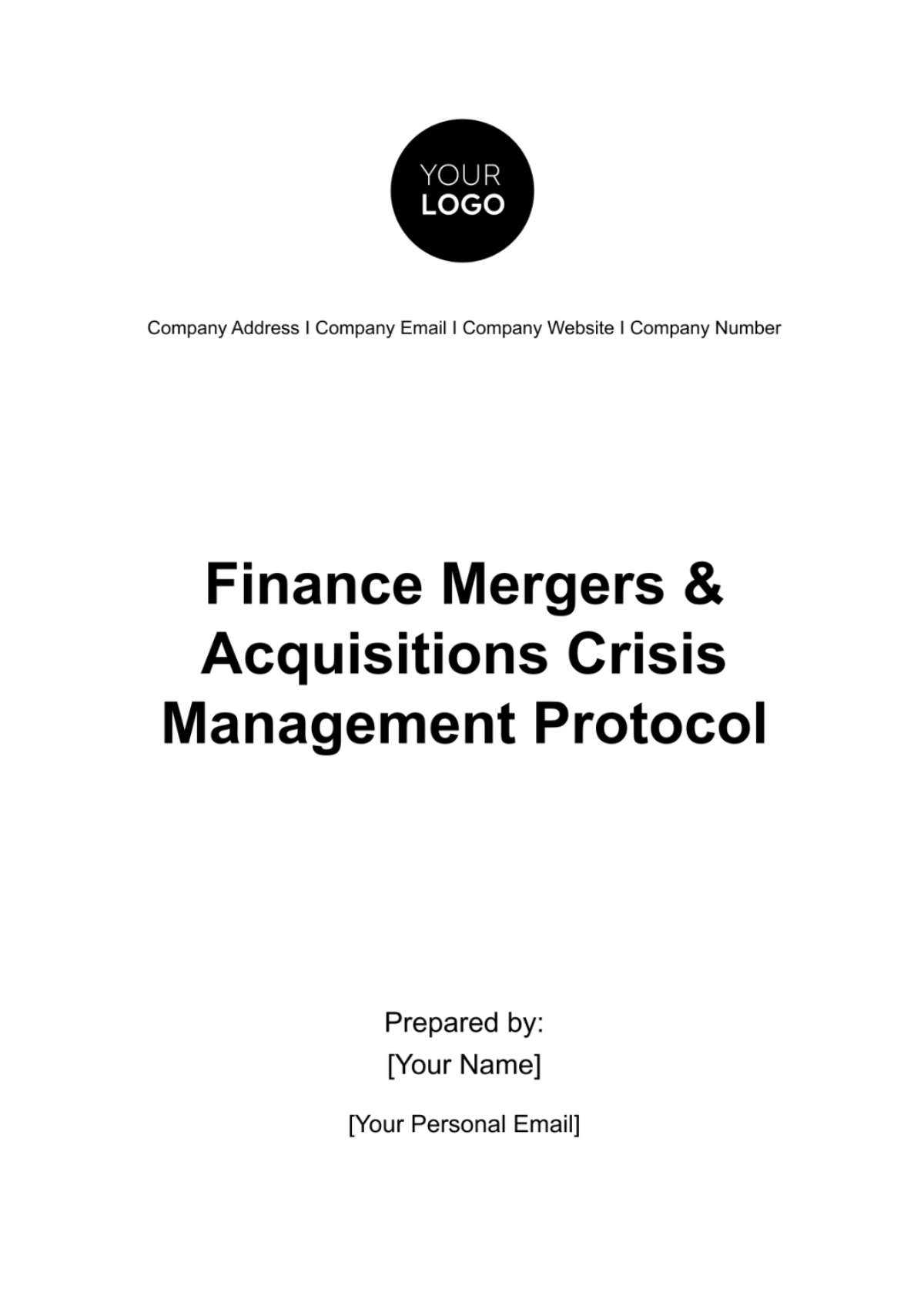Free Finance Mergers & Acquisitions Crisis Management Protocol

Executive Summary
A. Overview
The Finance Mergers & Acquisitions Crisis Management Protocol is an integral component of our organizational strategy, meticulously crafted to address the dynamic challenges that may arise during Mergers & Acquisitions (M&A) transactions. In the volatile landscape of financial transactions, this protocol serves as a beacon of resilience, guiding us through potential crises with precision and ensuring the sustained success of our M&A endeavors.
B. Objectives
Our objectives extend beyond crisis response; they embody our commitment to excellence and responsible corporate citizenship. Through the Finance Mergers & Acquisitions Crisis Management Protocol, we strive to achieve the following:
Timely Identification and Assessment: Swiftly recognize and assess potential crises during the intricate stages of M&A transactions, enabling a proactive response.
Dedicated Crisis Team Activation: Activate a specialized crisis management team promptly, comprising individuals with expertise in legal, financial, and public relations domains.
Effective Stakeholder Communication: Ensure transparent and effective communication with internal and external stakeholders, fostering trust and mitigating potential reputational damage.
Introduction
A. Purpose
At the core of this protocol is a clear and defined purpose – to provide a robust and adaptable framework for navigating the complexities of M&A transactions. Our purpose is to empower our organization with a structured response mechanism, enabling us to confront unforeseen challenges head-on and emerge stronger from potential crises.
B. Scope
The scope of this protocol is deliberately comprehensive, anticipating the diverse challenges that may manifest during M&A transactions. This includes, but is not limited to:
Financial Instability: Addressing challenges stemming from market fluctuations or funding uncertainties, securing our financial position in dynamic environments.
Regulatory Challenges: Navigating non-compliance issues and sudden regulatory changes, ensuring our actions align with legal requirements.
Stakeholder Concerns: Proactively managing stakeholder concerns, preventing opposition, negative perceptions, or loss of trust.
Operational Disruptions: Mitigating disruptions related to integration issues and system failures, safeguarding the smooth execution of our operations.
Key Contacts
A. Crisis Team Contacts
In times of crisis, a well-orchestrated response is crucial. The following key contacts form the core of our dedicated crisis management team, each bringing unique expertise to ensure a comprehensive and effective resolution:
Crisis Manager: John Dale
Contact Information: [Your Company Email], [Your Company Number]
Responsibilities: Orchestrates the overall crisis response, coordinates team actions, and liaises with senior management.
Legal Counsel: Jane Legal
Contact Information: [Your Company Email], [Your Company Number]
Responsibilities: Provides legal guidance, assesses regulatory implications, and ensures compliance throughout the crisis resolution.
Financial Advisor: Robert Finance
Contact Information: [Your Company Email], [Your Company Number]
Responsibilities: Advises on financial strategies, assesses potential losses, and collaborates on implementing remediation measures.
PR Representative: Sarah Public Relations
Contact Information: [Your Company Email], [Your Company Number]
Responsibilities: Manages communication with the media, crafts public statements, and safeguards the organization's reputation.
B. Communication Plan
Effective communication is paramount during a crisis. The Communication Plan outlines the steps for internal and external communication, ensuring a cohesive and transparent approach:
Internal Communication: Ensures that all team members are informed promptly, providing clear instructions and updates throughout the crisis.
External Communication: Addresses stakeholders, the media, and the public. A carefully crafted communication strategy aims to maintain trust and transparency.
Communication Channels: Utilizes various channels, including email, press releases, and social media, as appropriate to the nature and urgency of the crisis.
Timely Updates: Regular updates will be provided to stakeholders, keeping them informed about the progress of crisis resolution efforts.
Single Spokesperson: Designates a single spokesperson to maintain consistency and avoid confusion in external communications.
Risk Assessment
A. Identified Risks
An integral aspect of crisis management is the proactive identification of potential risks that may jeopardize the success of M&A transactions. Key risk categories include:
Financial Risks: [$10 million] potential financial loss due to market fluctuations or funding challenges.
Regulatory Risks: Legal penalties and fines, estimated at [$2 million], resulting from non-compliance or sudden regulatory changes.
Stakeholder Risks: Risk of opposition, negative perception, and loss of trust among stakeholders.
Operational Risks: Disruption of operations, estimated at [$5 million], delayed integration, and potential system failures.
B. Impact Analysis
Understanding the potential impact of identified risks is critical for informed decision-making and effective crisis response:
Financial Risks Impact: A potential loss of [$10 million], emphasizing the need for strategic financial remediation.
Regulatory Risks Impact: Legal penalties and fines may have far-reaching consequences, necessitating swift legal counsel involvement.
Stakeholder Risks Impact: Damage to reputation and loss of trust among stakeholders require meticulous communication strategies.
Operational Risks Impact: Disruption of operations could result in financial and reputational consequences, highlighting the importance of operational continuity measures.
Crisis Response
A. Trigger Events
Identifying specific trigger events is essential for the timely activation of the crisis response plan. Trigger events include:
Significant Financial Loss: Activation triggered if there is a potential financial loss exceeding [$5 million].
Legal Action: Immediate activation in response to legal actions, including litigation or regulatory investigations.
Stakeholder Opposition: Activation triggered by a significant negative reaction from stakeholders, potentially impacting the success of the M&A.
Operational Disruption: Activation in response to substantial disruptions in operations, such as system failures or integration challenges.
B. Team Activation
Upon the identification of trigger events, the Crisis Manager will activate the response team. Activation steps include:
Notification: Promptly notifying all crisis team members through designated communication channels.
Coordination: Coordinating team members' roles and responsibilities based on the nature of the crisis.
Initial Briefing: Conducting an initial briefing to ensure all team members are aligned on the crisis details and required actions.
C. Response Steps
Initial Assessment
Conducting a rapid assessment involves:
Gathering Information: Collecting data related to the crisis, including financial implications, legal aspects, stakeholder concerns, and operational impact.
Risk Prioritization: Prioritizing risks based on their potential impact on the success of the M&A.
Stakeholder Communication
Crafting clear and consistent messages for internal and external stakeholders:
Internal Communication: Keeping employees informed about the crisis, potential impacts on operations, and reassurances about management's actions.
External Communication: Developing transparent messages for shareholders, customers, and the media, emphasizing the organization's commitment to resolving the crisis.
Legal and Regulatory Compliance
Engaging legal counsel promptly to address legal and regulatory implications:
Legal Analysis: Assessing potential legal ramifications and formulating strategies for compliance and resolution.
Regulatory Engagement: Interacting with regulatory bodies, if necessary, to address compliance concerns.
Financial Remediation
Implementing financial strategies to mitigate losses:
Financial Assessment: Collaborating with financial advisors to assess the extent of financial losses and strategizing on potential recovery.
Remediation Planning: Developing and implementing plans to stabilize the financial situation and recover losses.
Crisis Resolution
A. Resolution Strategies
Outlined strategies for resolving the crisis include:
Negotiation and Settlement: Engaging in negotiations or settlements to address legal or financial disputes.
Reputation Management: Implementing reputation management strategies to rebuild trust among stakeholders.
Operational Recovery: Executing plans for the recovery of disrupted operations, ensuring minimal impact on the overall M&A process.
B. Evaluation Metrics
Defining key performance indicators (KPIs) to measure the effectiveness of crisis resolution efforts:
Financial Recovery Rate: Percentage of financial losses recovered after implementing remediation strategies.
Stakeholder Trust Index: Measurement of stakeholder trust levels through surveys and feedback mechanisms.
Operational Resilience: Assessment of how quickly and effectively operations return to normalcy after the crisis.
Post-Crisis Evaluation
A. Lessons Learned
In the aftermath of a crisis, conducting a thorough lessons learned review is crucial for continuous improvement. This involves:
Comprehensive Analysis: Undertaking a detailed analysis of the crisis response, examining both successes and areas for improvement.
Identification of Gaps: Identifying gaps in the crisis management protocol, team coordination, or communication strategies.
Documentation of Findings: Documenting findings to create a knowledge base for future crises and ensure continuous learning.
B. Documentation
Maintaining detailed documentation of the crisis, response actions, and outcomes is essential:
Timeline of Events: Creating a chronological timeline detailing when trigger events occurred, team activation, and key milestones during the crisis.
Communication Records: Archiving all communication records, including internal emails, external statements, and media interactions.
Financial Impact Analysis: Documenting the financial impact, the effectiveness of remediation strategies, and any recovery achieved.
Legal and Regulatory Documentation: Compiling legal assessments, regulatory responses, and any resolutions achieved in collaboration with legal counsel.
Continuous Improvement
A. Feedback Mechanism
Establishing a feedback mechanism ensures ongoing improvements to the crisis management protocol:
Team Debriefs: Conducting debrief sessions with the crisis team to gather insights into their experiences and recommendations for improvement.
Stakeholder Feedback: Seeking feedback from internal and external stakeholders on the effectiveness of communication and resolution efforts.
Anonymous Reporting: Implementing a confidential reporting system for team members to share concerns or suggestions without fear of reprisal.
B. Training and Drills
Ensuring readiness for future crises through regular training sessions and crisis drills:
Simulation Exercises: Conducting simulated crisis scenarios to test the effectiveness of the crisis response team and the protocol.
Role-specific Training: Providing targeted training for crisis team members based on their roles and responsibilities.
Scenario Analysis: Analyzing various potential crisis scenarios to enhance preparedness for a wide range of challenges.
Updating Protocols: Regularly reviewing and updating the crisis management protocol based on insights gained from training sessions and real-world experiences.
Conclusion
A. Summary
The Finance Mergers & Acquisitions Crisis Management Protocol is a dynamic and adaptive framework designed to navigate the complexities inherent in Mergers & Acquisitions (M&A) transactions. Throughout this protocol, we have outlined a comprehensive approach to crisis management, from the identification of trigger events to the resolution of crises and continuous improvement.
B. Key Takeaways
As we conclude, key takeaways include:
Proactive Identification: The protocol emphasizes the importance of proactive identification of potential crises, allowing for swift and effective response strategies.
Effective Communication: Clear and transparent communication, both internally and externally, is crucial for maintaining stakeholder trust during times of crisis.
Collaborative Response: The crisis management team, consisting of experts in legal, financial, and public relations domains, ensures a holistic and coordinated response.
Post-Crisis Evaluation: The post-crisis evaluation and continuous improvement mechanisms are integral for learning from experiences and enhancing the organization's crisis resilience.
C. Commitment to Excellence
In adopting this protocol, [Your Company Name] reaffirms its commitment to excellence, responsible corporate citizenship, and the success of its M&A endeavors. The Finance Mergers & Acquisitions Crisis Management Protocol is a living document that will be regularly reviewed, updated, and tested to ensure its effectiveness.
- 100% Customizable, free editor
- Access 1 Million+ Templates, photo’s & graphics
- Download or share as a template
- Click and replace photos, graphics, text, backgrounds
- Resize, crop, AI write & more
- Access advanced editor
Navigate the complexities of mergers and acquisitions seamlessly with our Template.net Finance Mergers & Acquisitions Crisis Management Protocol Template. This editable and customizable tool empowers you to implement effective crisis management strategies. Harness the potential of our Ai Editor Tool to tailor it to your needs, ensuring a resilient approach to crisis situations in the dynamic M&A landscape.





























